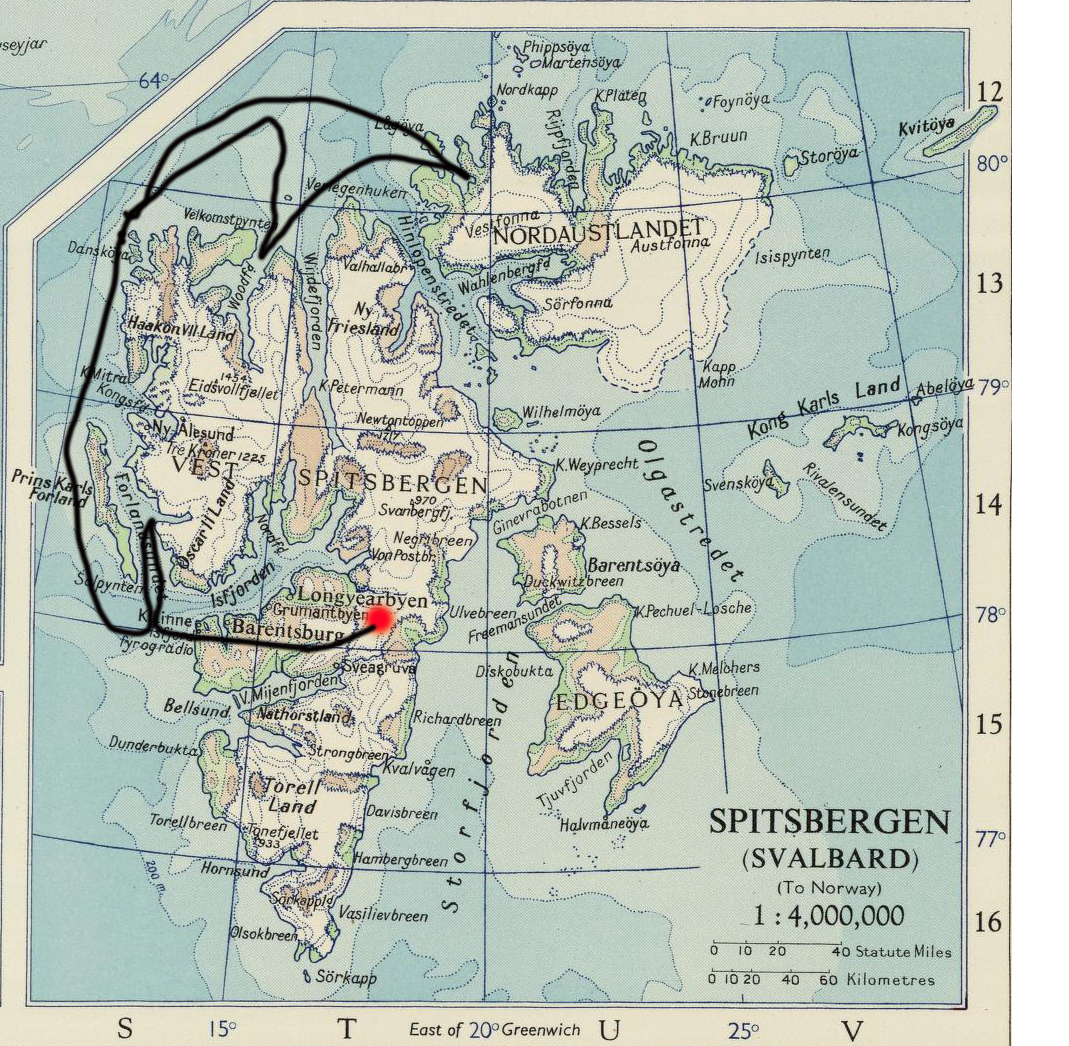
One week on board of the cruise "PLANCIUS" in the serach of the mitycal Polar Bera and other wildlife.
Artic Fox, Bearded Seal, Polar Bear, Ivory Gull, Walrus, Blue Whale,Svalvard Reindeer.
Spitsbergen is the name of the main island, whereas, Svalbard is the official name of the whole archipelago between 76°26’N (Bjørnøya) and 80°50’N (Sjuøyane) and 10°30’E and 28°10’E. Earlier, the main island was called Vest-Spitsbergen; this name is abandoned. The total land area is 62,450 km2, thereof 39,500 km2 on the main island Spitsbergen, Edgeøya with 5,150 km2, Barentsøya 1,300 km2, Prins Karls Forland 650 km2. Svalbard is under Norwegian administration and souvereignty, but citizens of all signatary nations have full access. To protect the environment and the cultural heritage and to ensure safety of travellers, there is a number of rules which Norwegian legislation and, mostly, also common sense provide.
The landscape is very varied because of the geology and the climate. Near the west coast of Spitsbergen, the landscape is very alpine with pointed mountains, which gave Spitsbergen its name. Central, northern and eastern parts of Svalbard tend to be more wide and open, with plateau-shaped mountains. The highest mountains are in northeastern Spitsbergen (Ny Friesland): Newtontoppen is 1,713 metres high, but is not very conspicuously towering above the surrounding, heavily glaciated high plateau – at least, when seen from a distance. The mountains near the west coast, towering above sea level still more than 1000 metres directly next to the fjords, appear to be more spectacular, such as Hornsundtind in Hornsund, south Spitsbergen’s highest mountain with 1431 metres. About 60% of Svalbard’s land area are glaciated, with an decreasing tendency because of climate change. The glaciated varies locally because of the local climate; precipitation and thus glaciation increase generally with altitude and to the west, which is the main source area for moist air. Also northern air masses bring a lot of snow, which is the reason for the vast glaciation of Nordaustland and Kvitøya with their wide ice caps. The west and northwest coast of Spitsbergen offer a range of spectacular fjords, whereas northeastern and eastern parts of Svalbard impress due to their remoteness and their striking landscapes.
 Day 1: Embarkation and departure from Longyerbyen
Day 1: Embarkation and departure from Longyerbyen
We arrive in Longyearbyen, the administrative capital of the Spitsbergen archipelago of which West Spitsbergen is the largest island. Before embarking there is an opportunity to stroll around this former mining town, whose parish church and Polar Museum are well worth visiting. In the surrounding area of Longyearbyen, more than 100 species of plants have been recorded. In the early evening the ship will sail out of Isfjorden, where in the mouth of the fjord we may see our first Minke Whale.
We sail to Raudfjord on the north coast of West Spitsbergen, a beautiful fjord dominated by spectacular glaciers and favoured by Ringed and Bearded Seal. The cliffs and shoreline of the fjord also support thriving seabird colonies and a surprisingly rich vegetation, which flourishes in sheltered spots. Polar bear are often seen here.
Depending on the weather we may now sail into Liefdefjorden, crui¬sing near the 5km long face of the impressive Monaco Glacier. The waters of the glacier front are a favorite feeding spot for thousands of Kittiwake. As well, Polar Bear have been seen on the glacier, providing wonderful opportunities for photography.
Today we will sail into Hinlopen Strait, home to Bearded Seal, Ringed Seal, Polar Bear, and Ivory Gull. At the entrance there is the possibility to see Blue Whale. We’ll navigate the ice floes of Lomfjordshalvøya in our zodiacs and explore the bird cliffs of Alkefjellet with thousands of Brünnich’s Guillemot. On the east side of Hinlopen Strait, we’ll attempt a landing at Palanderbukta on Nordaustlandet, home to reindeer, Pink-footed Goose, breeding Ivory Gull, and Walrus.
We will try reach our northernmost point at Phippsøya, in the Seven Islands north of Nordaustlandet. Here we will be at 81 degrees north, just 540 miles from the geographic North Pole. Polar Bear inhabit this region, along with Ivory Gull. The ship may sit for several hours in the pack ice, before turning west again.
Retracing our route westwards, our route takes us through and along the pack ice, keeping watch for Polar Bear and the elusive Greenland Whale (Bowhead). About 40 nautical miles west of Spitsbergen we sail along the edge of the continental shelf, where Fin Whale forage in summer in the upwelling’s along the Spitsbergen banks. At the mouth of the Kongsfjorden we have also good chances to see Minke Whale.
In Forlandsundet at Sarstangen is a haul out place for Walrus. Alternatively we sail into St. Johns Fjord or south to the mouth of Isfjorden and land at Alkhornet. Seabirds nest on its cliffs and Arctic Fox search the cliff base for fallen eggs and chicks, while Spitsbergen Reindeer graze the relatively luxuriant vegetation. At nighttime we arrive in Longyearbyen.
We disembark in Longyearbyen, the administrative centre of Spitsbergen, for the flights south to Oslo and onward home.
About the cruise "PLANCIUS" https://oceanwide-expeditions.com/our-fleet/m-v-plancius